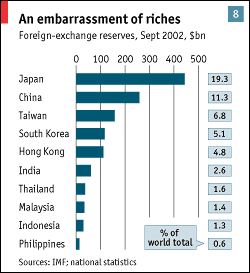
|
|
|
 |
|
MOST developing regions have a surplus of labour but a shortage of capital. Developing Asia is different. Certainly, it has a surplus of labour, a huge one now that China has joined the world economy; but it also has a surplus of capital. Not only are Asia's savings rates extraordinarily high (nearly 40% of GDP in China), most economies in the region also run hefty current-account surpluses and pile up dollars. Where do these dollars go?
Mainly to the region's central banks, rather than to individual citizens. Asian central banks hog the world's foreign-exchange reserves (see chart 8). Governments see their hefty reserves as an insurance against the vicious swings of a globalised economy—and against any future crisis on the scale of 1997-98. The reserves are their virility symbol.
Oddly, though, the money is not doing much good in the region. After all, capital markets there are neither deep nor liquid enough to absorb them. Rather, the dollars go back to the rich world, notably to America. Asia funds something like half of America's huge current-account deficit, and Asian central banks are among the biggest net foreign purchasers of American Treasury bonds. And then the dollars come back to Asia in the form of portfolio flows and foreign direct investment: not the same dollars, true, but money is fungible. Andrew Sheng, chairman of Hong Kong's Securities and Futures Commission, says that it reminds him of the debate in the 1950s about money from Britain's colonies going to the imperial centre and coming back in the form of colonial investments.
A growing body of opinion is starting to question Asia's high foreign-exchange reserves. Increasingly they are being viewed less as a virility symbol than as a kind of covert tax—a cost of the region's imbalanced model of export-driven growth and of a vulnerable financial sector. Still, few citizens really begrudge their governments holding the world's super-currency, particularly when so many of those governments have a recent record of debasing their own monies.
The risk to the high-reserve policy is a steep fall in the dollar. Most Asian central bankers still won't hear of this. A world dollar standard has, in effect, prevailed since the gold standard was abandoned in 1971. And the Federal Reserve under Alan Greenspan has been a staunch guardian of sound money. Yet there is a danger of deflation in America, and after a series of interest-rate cuts the Federal Reserve has only 1.25 percentage points above zero to play with.
Late last year one Federal Reserve governor, Ben Bernanke, explained that the Fed, if necessary, had abundant powers to avert deflation. “Like gold,” he said, “US dollars have value only to the extent that they are strictly limited in supply. But the US government has a technology called a printing press (or, today, its electronic equivalent) that allows it to produce as many US dollars as it wishes at essentially no cost. If we do fall into deflation, we can take comfort that the logic of the printing-press example must assert itself.” Asia's central banks had better watch out.